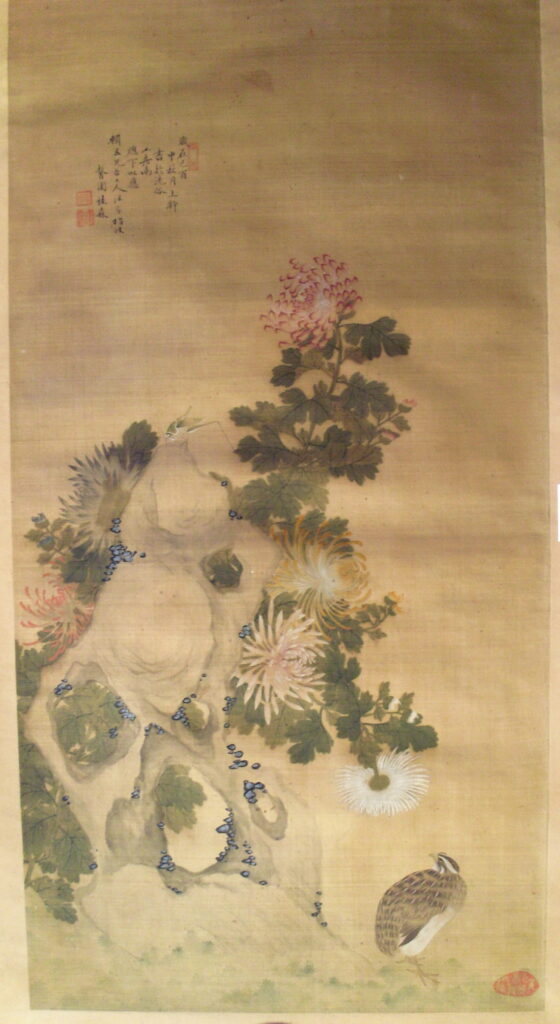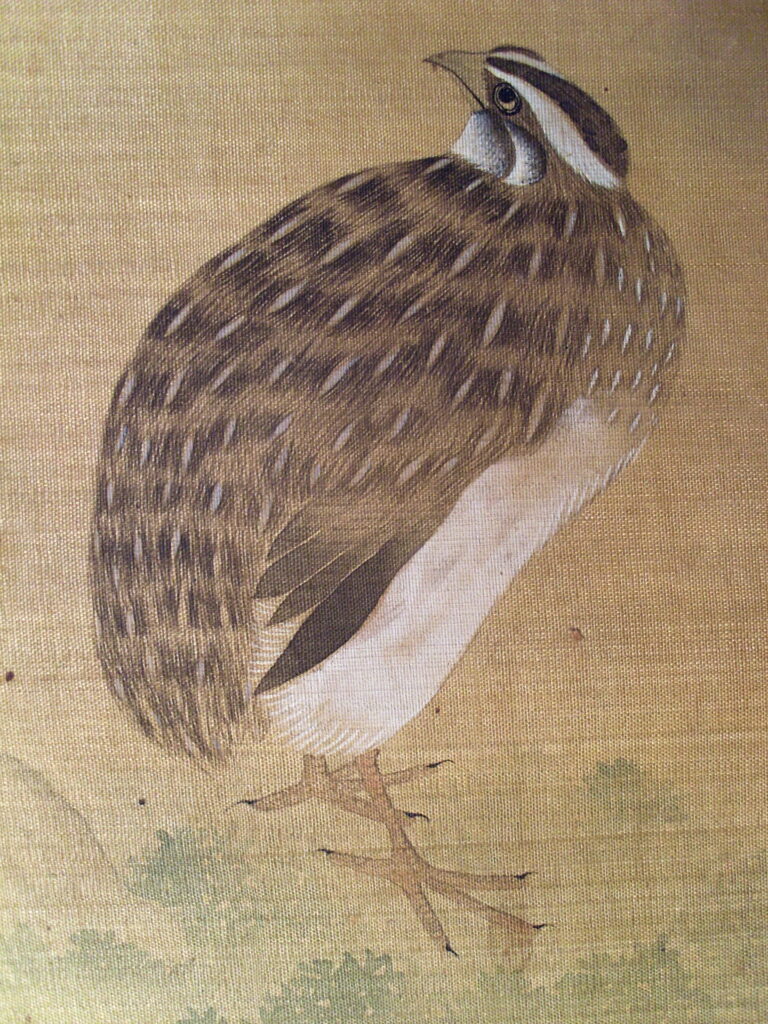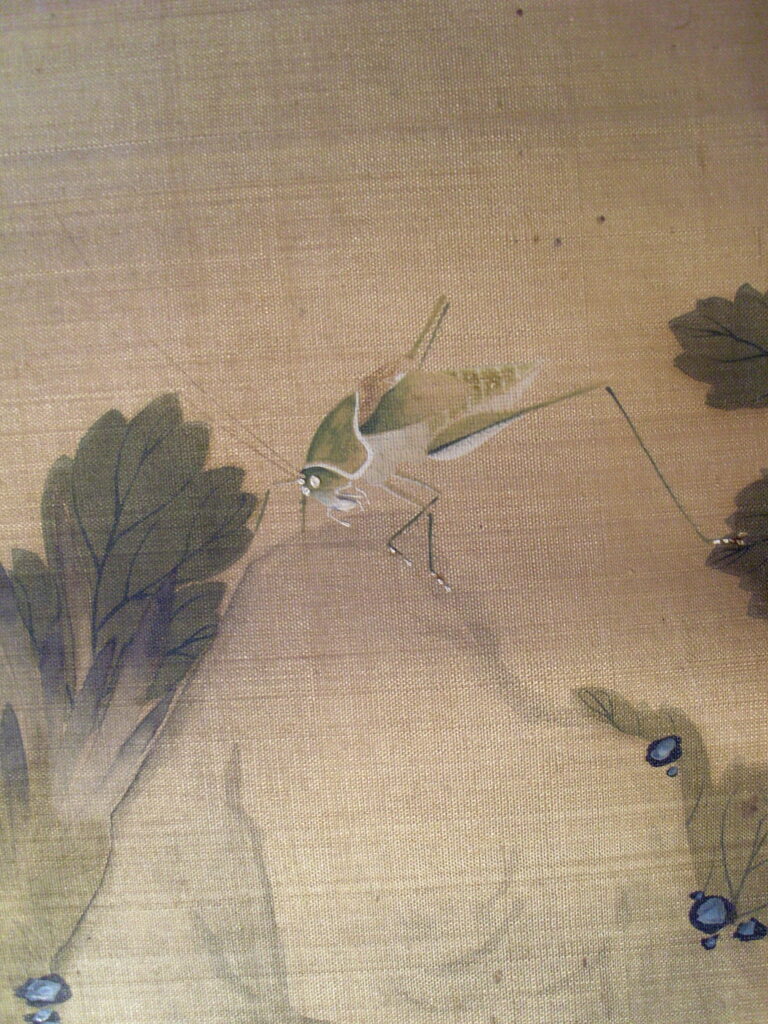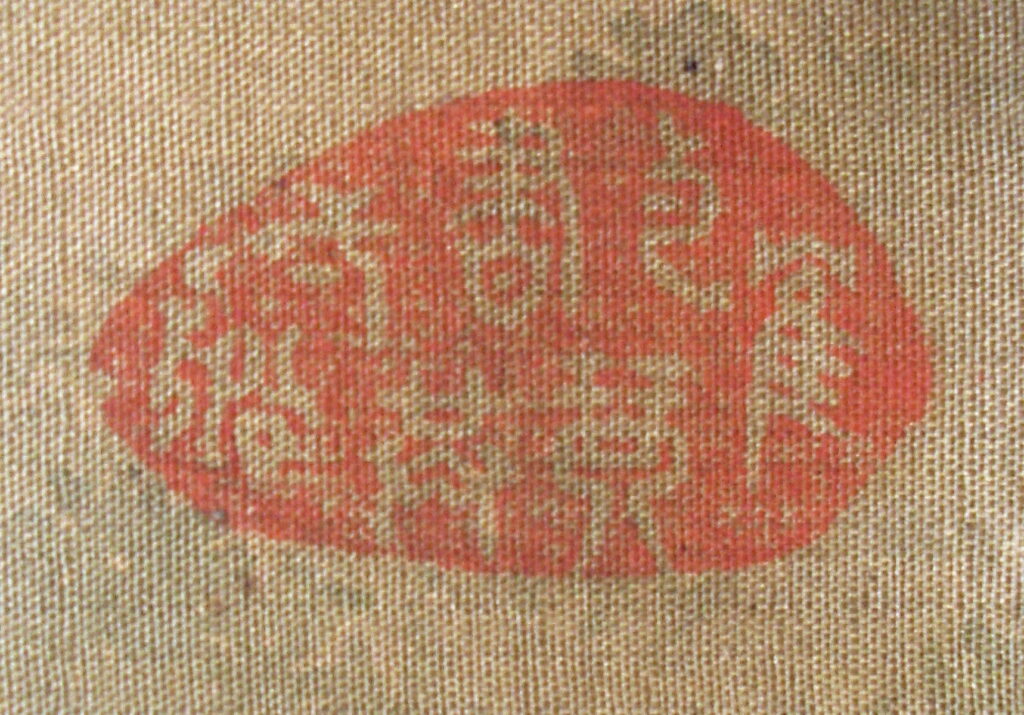by Marta Logvyn (PhD student at the Scientific and Educational Institute of Philology of Taras Shevchenko Kyiv National University, leading research fellow of the Asian art department, the Khanenko Museum, Kyiv, Ukraine)
The author wishes to thank her fellow Ph.D. student Xiu Wei for his help in translating an inscription on a seal print

Author: Signed 馨園桂森 Xin Yuan Gui Sen
Title: A quail under a chrysanthemum bush
Dating: 1909 (?)
Materials: Ink and colors on silk
Dimensions: 82 х 43 cm
Place of Execution: China
Inventory number: 373 ЖВ
Museum: The Bohdan and Varvara Khanenko National Museum of Art, Kyiv, Ukraine
Chrysanthemums and a garden rock tower over a small bird. A small grasshopper sits on top of a garden rock. The whole picture is executed meticulously, in a decorative way. Even a seal print at the bottom right looks like a pebble in a garden, and this fact entertains us as much as the whole composition in the “birds and flowers” genre.
A painting was created at the time of the Mid-Autumn Festival. At first sight, it is imbued purely with auspicious symbols just suiting the occasion. Lush chrysanthemums are seasonal flowers. A chrysanthemum also stands for a talented “noble” person. Moreover, a chrysanthemum is a symbol of longevity since 菊花 júhuā for “chrysanthemum” sounds close to久jiǔ “long, permanent”.
A quail is a symbol of fecundity and peace since this bird lays lots of eggs, and “ānchún” 鵪鶉 for “quail” sounds close to “ān” 安 for “peace” and chūn 春 for “spring”.

Small insects like grasshoppers also symbolize fertility for the same reasons as quail: they breed fast and in high numbers. Yet there is another meaning in the picture. A perfect proportion of flowers and a stone slab to the size of the insect’s body seem to be like a mountain and a forest to a human. The very insect is depicted in a stage of a nymph, which is an intermediate stage in its development. The quail on the ground seems to notice the insect and it is ready to feast on it.

This way a peaceful scene becomes a scene of deep tension. We are left with open questions. Will the grasshopper escape the quail? Is it smart enough to hide in a maze of porous stone? Will it develop fully before the first chills of winter and will it be able to hibernate well into spring? We also can’t avoid a metaphorical projection of this scene into the human world.
At the same time, some linguistic material present in the painting has nothing to do with this idea of perils. Contrary to the pictorial metaphors, a seven-character inscription on the seal print in a shape of a pebble is quite carefree and hedonistic: 美人琴書共一船 “A beautiful lady, a cither, [and] books [are aboard] the same boat”. These words are a paraphrase of a quote from Bai Juyi’s poem 自喜 “Self-content”: 鶴與琴書共一船 literary “A crane is aboard on the same boat with books and a cither”. This quote became an idiom that stands for a tranquil attitude and satisfaction with life.

Considering all this layering of ideas in the same tableau I won’t be surprised if colleagues may discover and point out to more ideas imbued in this intricate piece!
The theme of “birds and flowers” painting and auspicious puns in the Chinese art is really vast. I would suggest two amazing sources, which are a book and an article:
- 焦俊梅.十二月花神. 湖南美术出版社 2011年156 页 ISBN 9787535644992
- Bai, Qianshen. “Image as Word: A Study of Rebus Play in Song Painting (960-1279).” Metropolitan Museum Journal, vol. 34, 1999, pp. 57–12.
Автор: Підписано 馨園桂森 Сінь Юань Ґвей Сень
Назва: Перепілка під кущем хризантеми
Час створення: 1909 (?)
Матеріали і техніки: Шовк, туш, водорозчинні фарби
Розмір: 82 х 43 см
Країна створення: Китай
Інвентарний номер: 373 ЖВ
Музей: Національний музей мистецтв імені Богдана та Варвари Ханенків, Київ, Україна
Дякую аспіранту Навчально-Наукового Інституту Філології КНУ імені Тараса Шевченка Сьов Вею за допомогу в перекладі напису на печатці
Над невеликою птахою височіють хризантеми та брила ажурного ландшафтного валуна. На вершині валуна сидить коник. Всю картину виконано ретельно, у декоративній манері. Навіть печатка внизу праворуч схожа на камінчик у саду, і цей факт нас розважає так само, як і вся композиція в жанрі «квіти і птахи».
Цю картину створено в час, коли відзначають Свято середини осені. На перший погляд, вона сповнена суто доброзичливими символами, які пасують святкуванню. Пишні хризантеми – сезонні квіти. Також хризантема символізує талановиту «благородну» людину. А ще хризантема є символом довголіття, адже слово 菊花 júhuā «хризантема» звучить подібно до久 jiǔ «тривалий; вічний» .
Перепілка є символом плідності та миру і весни, оскільки ця пташка несе багато яєць, а китайське слово “ānchún” 鵪鶉 «перепілка» звучить схоже на ān 安 «мир» та chūn 春 «весна». Дрібні комахи, як-от коники, означають плідність із тієї ж причини, що й перепілка: вони швидко розмножуються у великій кількості.
Проте в картині приховано й інший смисл. Ідеальна пропорція квітів та валуна до розміру тільця комахи подібна до пропорції гори і лісу до людського тіла. Саму комаху зображено в стадії німфи – проміжного етапу в її розвитку. А перепілка, здається, вже помітила комаху і готова нею поласувати.
Ось так у мирній сцені з’являється внутрішня напруга. Ми лишаємося із відкритими питаннями. Чи зуміє коник врятуватися від перепілки? Чи здогадається сховатися в лабіринті пористого каменю? Чи встигне повністю розвинутися до перших морозів і безпечно спати до весни? Врешті, ми не можемо уникнути метафоричної проекції цієї сцени на світ людей.
Одночасно певний мовний матеріал, присутній на картині, не має нічого спільного з темою небезпеки. На відміну від візуальних метафор, напис на печатці у формі камінчика, що складається з семи знаків, має досить безжурний і гедоністичний зміст: 美人琴書共一船 «Красуня, цитра і книги – всі в одному човні». Це змінена цитата з вірша Бай Дзюйї 自喜 «Самовдоволеність»: 鶴與琴書共一船, тобто «Журавель разом із цитрою та книгами – в одному човні». Рядок вірша став крилатою фразою, що перетворилася на фразеологізм, який позначає душевний спокій та задоволення життям.
Зважаючи на таке нашарування ідей в одному живописному творі, я не здивуюся, якщо колеги знайдуть і вкажуть мені на ще більше смислів, якими сповнена ця складна картина!
Марта Логвин, аспірантка Науково-Навчального Інститут Філології Київського Національного Університету імені Тараса Шевченка, провідна наукова співробітниця відділу мистецтв країн Азії Музею Ханенків, Київ, Україна
Тема жанру «квіти і птахи» в китайському мистецтві надзвичайно широка. Я б порадила два захопливих джерела: книгу і статтю
- 焦俊梅.十二月花神. 湖南美术出版社 2011年156 页 ISBN 9787535644992
- Bai, Qianshen. “Image as Word: A Study of Rebus Play in Song Painting (960-1279).” Metropolitan Museum Journal, vol. 34, 1999, pp. 57–12.